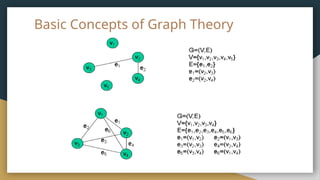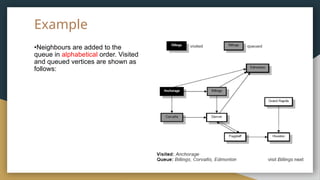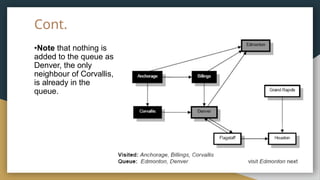Graph Data Structure on social media analysis
- 1. Graph Data Structure By : I Kadek Agus Wahyu Raharja (23219019) Arief Nur Rahman (23219034)
- 2. Outline 1. History of Graph Theory 2. Application of Graph 3. Basic Concepts of Graph Theory 4. Graph Terminology 5. Representation of Graph
- 3. History of Graph Theory The origin of graph theory can be traced back to Euler's work on the Konigsberg bridges problem (1735), which led to the concept of an Eulerian graph. The study of cycles on polyhedra by the Thomas P. Kirkman (1806 - 95) and William R Hamilton (1805-65) led to the concept of a Hamiltonian graph.
- 4. History of Graph Theory ● Begun in 1735 ● Mentioned in Leonhard Euler's paper on "Seven Bridges of Konigsberg". ● Problem : Walk all 7 bridges without crossing a bridge twice
- 5. History of Graph Theory ● Cycles in Polyhedra - polyhedron with no Hamiltonian cycle Thomas P. Kirkman William R. Hamilton
- 6. Application of Graph ● In many cases we are faced with a problem that is defined in terms of a number of objects or entities that have some relationships among them. We then try to answer interesting questions. ○ Flight scheduling ○ Traveling ○ Circuit layout, etc ● Graphs are the basic mathematical formulation we use too tackle such problems. ○ Basic definitions and properties. ○ Computer representation. ○ Some applications.
- 7. Application of Graph ● Electronic circuits ○ Printed circuit board ○ Integrated circuit ● Transportation networks ○ Highway network ○ Flight network ● Computer networks ○ Local area network ○ Wide area network ○ Internet ● Databases ○ Entity-relationship diagram
- 8. Basic Concepts of Graph Theory A Graph G consists of a set V of vertices or nodes and a set E of edges that connect the vertices. We write G=(V,E).
- 9. Basic Concepts of Graph Theory
- 10. Graph Terminology Classification of Graph Terms 1. Global terms refer to a whole graph 2. Local terms refer to a single node in a graph
- 11. Graph Terminology Connected and Isolated Vertex ● Two vertices are connected if there is a path between them ● Isolated vertex - not connected Isolated Vertex
- 12. Graph Terminology Adjacent nodes ● Two nodes are adjacent if they are connected via an edge. ● If edge e={u,v} ϵ E(G), we say that u and v are adjacent or neighbors ● An edge where the two end vertices are the same is called a loop, or a self-loop
- 13. Graph Terminology Degree (Un Directed Graphs) ● Number of edges incident on a node Degree of node 5 is 3
- 14. Graph Terminology Degree (Directed Graphs) ● In-degree: Number of edges entering ● Out-degroo: Ntunber of edges leaving ● Degree = indegree + outdegree outdeg(1)=2 indeg(1)=0 outdeg(2)=2 indeg(2)=2
- 15. Graph Terminology Walk ● trail: no edge can be repeat a-b-c-d-e-b-d ● walk: a path in which edges/no can be repeated a-b-d-a-b-c ● A walk is closed if a=c
- 16. Graph Terminology Paths ● Path: is a sequence P of nodes v(1), v(2), … , v(k-1), v(k) ● No vertex can be repeated ● A closed path is called a cycle ● The length of a path or cycle is the number of edges visited in the path or cycle Walk and Path 1,2,5,2,3,4 1,2,5,2,3,2,1 1,2,3,4,6 Walk of length 5 CW of length 6 path of length 4
- 17. Graph Terminology Cycle ● Cycle - closed path: cycle (a-b-c-d-a) , closed if x=y ● Cycles denoted by C(k), where k is the number of nodes in the cycle
- 18. Graph Terminology Shortest Path ● Shortest Path is the path between two nodes that has the shortest length ● Length - number of edges. ● Distance between u and v is the length of a shortest path between them ● The diameter of a graph is the length of the longest shortest path between any pairs of nodes in the graph
- 19. Representation of Graph ● The adjacency matrix for a graph G=(V,E) with n (or |V|) vertices numbered 0, 1, …, n-1 is an n x n array M such that M[i][j] is 1 if and only if there is an edge from vertex i to vertex j. ● The adjacency list for a graph G=(V,E) with n vertices numbered 0, 1, …, n-1 consists of n linked lists. The ith linked list has a node for vertex j if and only if the graph contains and edge from vertex i to vertex j.
- 20. Adjacency Matrix ● Let G=(V,E) be a graph with n vertices. ● The adjacency matrix of G is a two-dimensional n by n array, say adj_mat ● If the edge (vi, vj) is in E(G), adj_mat[i][j]=1 ● If there is no such edge in E(G), adj_mat[i][j]=0 ● The adjacency matrix for an undirected graph is symmetric; since adj_mat[i][j]=adj_mat[j][i] ● The adjacency matrix for a digraph may not be symmetric
- 21. Adjacency Matrix
- 22. 1 2 3 4 5 6 7 1 0 1 1 1 0 0 0 2 0 0 0 1 1 0 0 3 0 0 0 0 0 1 0 4 0 0 1 0 0 1 1 5 0 0 0 1 0 0 1 6 0 0 0 0 0 0 0 7 0 0 0 0 0 1 0 Adjacency Matrix
- 23. •From the adjacency matrix, to determine the connection of vertices is easy •The degree of a vertex is •We can also represent weighted graph with Adjacency Matrix. Now the contents of the martix will not be 0 and 1 but the value is substituted with the corresponding weight. Adjacency Matrix
- 24. ● A Single Dimension array of Structure is used to represent the vertices ● A Linked list is used for each vertex V which contains the vertices which are adjacent from V (adjacency list) Adjacency Matrix
- 25. Adjacency Matrix
- 26. Adjacency Matrix
- 27. Adjacency Matrix
- 28. ● Edge List ● Adjacency List (node list) Adjacency List
- 29. Graph Traversal •Traversal is the facility to move through a structure visiting each of the vertices once. •We looked previously at the ways in which a binary tree can be traversed. Two of the traversal methods for a graph are breadth- first and depth-first.
- 30. Breadth-First Graph Traversal •This method visits all the vertices, beginning with a specified start vertex. It can be described roughly as “neighbours-first”. •No vertex is visited more than once, and vertices are visited only if they can be reached – that is, if there is a path from the start vertex. •Breadth-first traversal makes use of a queue data structure. The queue holds a list of vertices which have not been visited yet but which should be visited soon. •Since a queue is a first-in first-out structure, vertices are visited in the order in which they are added to the queue. •Visiting a vertex involves, for example, outputting the data stored in that vertex, and also adding its neighbours to the queue. •Neighbours are not added to the queue if they are already in the queue, or have already been visited.
- 31. Example •Neighbours are added to the queue in alphabetical order. Visited and queued vertices are shown as follows:
- 32. Cont. •Note that we only add Denver to the queue as the other neighbours of Billings are already in the queue.
- 33. Cont. •Note that nothing is added to the queue as Denver, the only neighbour of Corvallis, is already in the queue.
- 34. Cont.
- 35. Cont.
- 36. Cont. •Note that Grand Rapids was not added to the queue as there is no path from Houston because of the edge direction. •Since the queue is empty, we must stop, so the traversal is complete. •The order of traversal was:Anchorage, Billings, Corvallis, Edmonton, Denver, Flagstaff, Houston
- 37. Depth-First Traversal 1.Depth-first traversal of a graph: 2.Start the traversal from an arbitrary vertex; 3.Apply depth-first search; 4.When the search terminates, backtrack to the previous vertex of the finishing point, 5.Repeat depth-first search on other adjacent vertices, then backtrack to one level up. 6.Continue the process until all the vertices that are reachable from the starting vertex are visited. 7.Repeat above processes until all vertices are visited.
- 38. Depth First Search Traversal •This method visits all the vertices, beginning with a specified start vertex. •This strategy proceeds along a path from vertex V as deeply into the graph as possible. •This means that after visiting V, the algorithm tries to visit any unvisited vertex adjacent to V. •When the traversal reaches a vertex which has no adjacent vertex, it back tracks and visits an unvisited adjacent vertex. •Depth-first traversal makes use of a Stack data structure.
- 39. Example
- 40. Cont.


















![Representation of Graph
● The adjacency matrix for a graph G=(V,E) with n (or |V|) vertices
numbered 0, 1, …, n-1 is an n x n array M such that M[i][j] is 1 if
and only if there is an edge from vertex i to vertex j.
● The adjacency list for a graph G=(V,E) with n vertices numbered 0,
1, …, n-1 consists of n linked lists. The ith
linked list has a node for
vertex j if and only if the graph contains and edge from vertex i to
vertex j.](https://image.slidesharecdn.com/graphdatastructure-240909154215-0fc11f11/85/Graph-Data-Structure-on-social-media-analysis-19-320.jpg)
![Adjacency Matrix
● Let G=(V,E) be a graph with n vertices.
● The adjacency matrix of G is a two-dimensional
n by n array, say adj_mat
● If the edge (vi, vj) is in E(G), adj_mat[i][j]=1
● If there is no such edge in E(G), adj_mat[i][j]=0
● The adjacency matrix for an undirected graph is symmetric; since
adj_mat[i][j]=adj_mat[j][i]
● The adjacency matrix for a digraph may not be symmetric](https://image.slidesharecdn.com/graphdatastructure-240909154215-0fc11f11/85/Graph-Data-Structure-on-social-media-analysis-20-320.jpg)



















